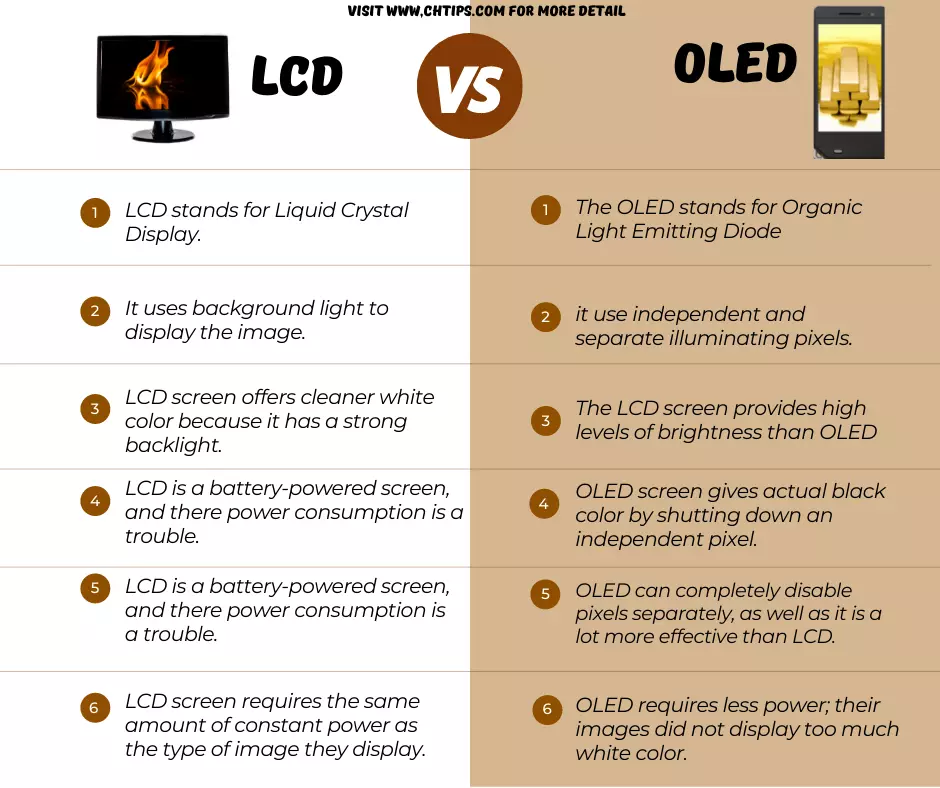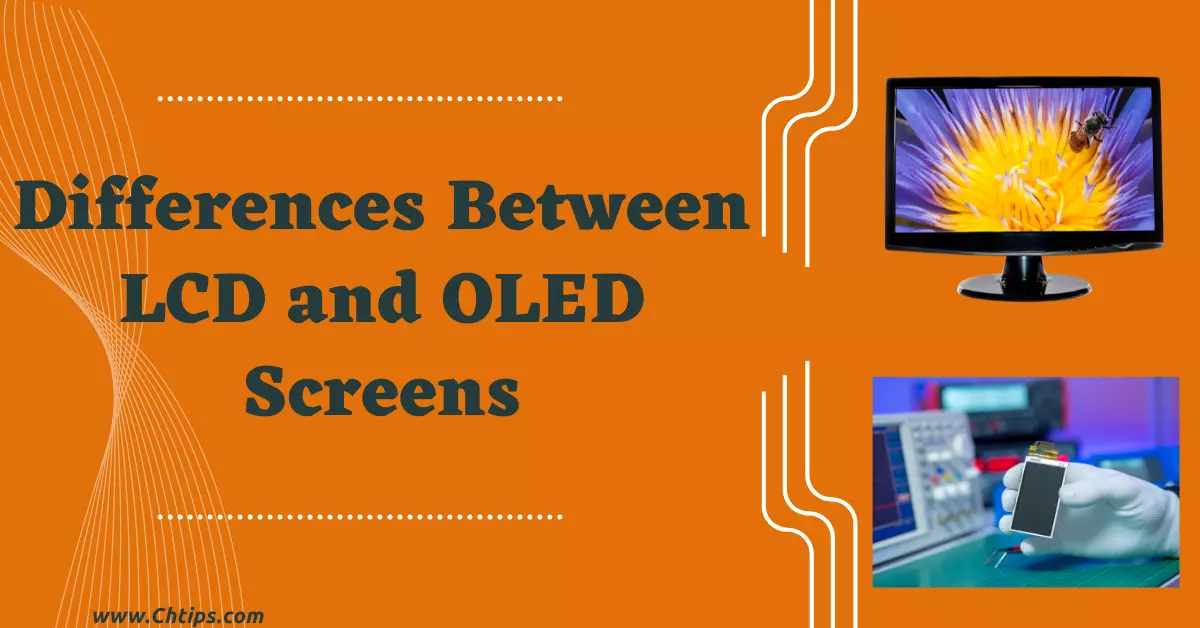In today’s article we are going to learn and discuss on what are the differences between LCD and OLED screens with meaning, description, applications and definition.
The Full Form of LCD is Liquid Crystal Display.
The Full Form of LED is Light Emitting Diode.
Differences Between LCD and OLED Screens With Image

What is LCD in Computer?
LCD stands for Liquid Crystal Display.
The LCD is a flat panel display used in computers, laptops, and television, and also used in mobile devices like laptops, tablets, or smartphones.
It looks and works like CRT (Cathode Ray Tube) also not bulky like a CRT monitor. It does not work by hitting the electron on the glass screen.
LCD has a backlight situated in a rectangular grid that organizes pixels to give multiple lights on the LCD screen, each pixel has RGB (red, blue, green) sub-pixel color, and it can also be turned on or off.
When the pixel of the sub-pixel is stopped or closed, there is no spreading of colors, and the screen appears black, every sub-pixel starts the screen with white color, also the combination of red, blue, and green color give the combination of thousands of colors.
LCDs are slim and light in weight and use minimum power than CRTs. It takes less electricity.
LCD works on the principle of blocking light and not hitting the light on the screen.
The excessive use of CRT monitors negatively affects the eyes to overcome this problem you need to change the screen, to LCD.
Friedrich Reinitzer and Austrian Botanist discovered the first liquid crystal in cholesterol in 1888.
What is OLED in Computer?
The OLED stands Organic Light Emitting Diode.
It is also a light-emitting technology, and it is made up of a series of organic thin films which are placed simultaneously one after another between two conductors.
When an electric current passes through them, it emits a shining and glittering light. OLED is an emissive display.
It does not need any backlight, and it is skinny compared to LCD and also well organized.
OLED provides better image quality, and it is transparent, flexible, and foldable, and it can also be rollable and stretchable in the near future.
OLED produces electrons and holes with the help of organic molecules.
A simple OLED comprises six different layers in which on its top and bottom there is protective glass, and plastic layers are present to protect it where the top layer is called a seal and the bottom layer is called the substrate.
Between these layers, there is one negative terminal, and one positive; there are anode and cathode between two layers made up of organic molecules called emissive and conductive layers.
Modern OLED devices contain multiple layers with multiple layers it becomes more efficient and durable.
Earlier OLED device was developed by Ching W. Tang and Steven Van Slyke in 1987; there are several further developments in this technology.
Difference Between LCD and OLED Screens
| LCD | OLED |
| LCD stands for Liquid Crystal Display. It uses background light to display the image. | The OLED stands for Organic Light Emitting Diode and it uses independent and separate illuminating pixels. |
| On the LCD screen, light is handled by the screen, and the light goes through the pixels on the screen. | An OLED screen has each pixel with its background light, and thus it provides its light independently. |
| LCD screens do not brighten up pixels independently. They use background light and also a pixel panel that obstructs the white light behind it to develop colors | OLED can turn each on and off each pixel independently to provide good and better quality pictures. |
| LCD screen offers cleaner white color because it has a strong backlight. | OLED did not need any background light when an electric current passed through it emits light. The LCD screen provides high levels of brightness than OLED. |
| LCD is a battery-powered screen, and their power consumption is troublesome. | OLED screen gives actual black color by shutting down an independent pixel. |
| LCDs require more power as they display lots of colors as display white. | OLED can completely disable pixels separately, as well as it is a lot more effective than LCD. |
| LCD screen requires the same amount of constant power as the type of image they display. | OLED requires less power; their images did not display too much white color. OLED needs more power to activate pixels. |
| LCD does not have any of that kind of component, and its life is more than OLED. | OLED is more expensive than LCD. |
Related Articles
- Advantages and Disadvantages of Microcontroller
- Advantages and Disadvantages of Magnetic Disk
- Advantages and Disadvantages of Optical Disk
- Advantages and Disadvantages of Microprocessor
- 20 Advantages and Disadvantages of Mobile Phones
- Advantages and Disadvantages of CRT Monitors
- Advantages and Disadvantages of CCTV Cameras
- Advantages and Disadvantages of Blu-Ray Disk
- Advantages and Disadvantages of Fifth Generations of Computer System
- Advantages and Disadvantages of Bluetooth
- Advantages and Disadvantages of SATA
- Differences Between LCD and OLED Screens
- Advantages and Disadvantages of Speakers
- Differences Between Software Engineering and System Engineering
- 11 Similarities Between Hardware and Software
- Computer Basic Tutorials
Applications of LCD Screens
- Liquid Crystal Display (LCDs) is used in aircraft display screens.
- The LCD screen is used in the display of calculators.
- LCD is also used in digital cameras for displaying images.
- In televisions, the use of LCD screens is observed.
- Most computer monitor screens are made of LCDs.
- It is used in the instruments panel where all the lab instruction uses LCD screens for display.
- LCDs are commonly used in all digital watches for displaying time.
- Mobile Phones uses LCD screen for display.
- LCD screens are not costly, and they have no limitations when it comes to displaying special characters.
- LCD has a thin display, and it is energy efficient.
Applications of OLED Screens
- Screens OLED screens are mostly utilized used in digital devices such as high-end television systems, computer system monitors, and also pocket-size systems such as android phones, video games, and electronic video cameras.
- Such types of applications need high reliability and also readability. OLED fits in these take in less power and supply a high-quality display screen.
- The current OLED technology provides remarkable color integrity, high efficiency, and operational stability.
- Some mobile phones may have OLED screens like Samsung, Gionee, Oppo, One plus, Google Pixel, and iPhone.
- Some LED TVs are turned into OLED.
Get In Touch
I have also written and compiled some articles on computers and telecommunications, and please go through them.
I hope you will like reading it.
I hope that all the questions and queries related to 11 Differences Between LCD and OLED Screens have been answered here.
Don’t hesitate to get in touch with me, and if you need to add, remove or update anything from the article, please let me know in the comment section or via email.
I will be more than happy to update the article. I am always ready to correct myself.
Please share this article with your friends and colleagues; this motivates me to write more related topics.
!!! Thank You !!!

Comments are closed.